Fractal Design Define XL R2 Case Review: Maybe We Can Have It All?
by Dustin Sklavos on February 20, 2013 12:01 PM EST- Posted in
- Cases/Cooling/PSUs
- quiet
- Fractal Design
- ATX
Noise and Thermal Testing
I went into testing the Fractal Design Define XL R2 feeling a little skeptical. The Define R4 wasn't a bad case by any stretch of the imagination, but it was an underwhelming one, and it was pretty swiftly eclipsed by Nanoxia's Deep Silence case designs. That in mind, I didn't think the XL R2 would be a poor case, but it needed to be more than an also-ran and it needed to clear the same hurdle every other quiet case must: it had to provide good thermal performance.
Per usual testing procedures, the XL R2 was tested with the middle drive cage removed, and tested at each fan setting available. Ambient temperature during testing was ~22C.
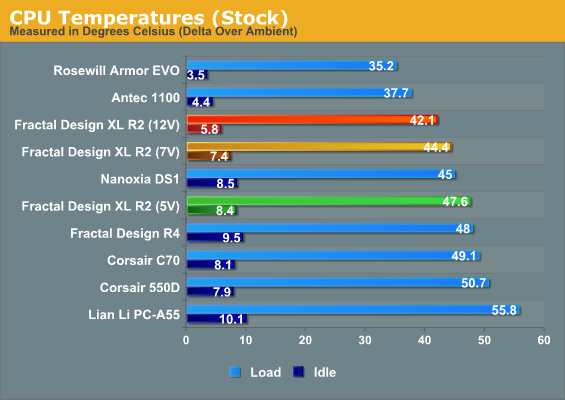
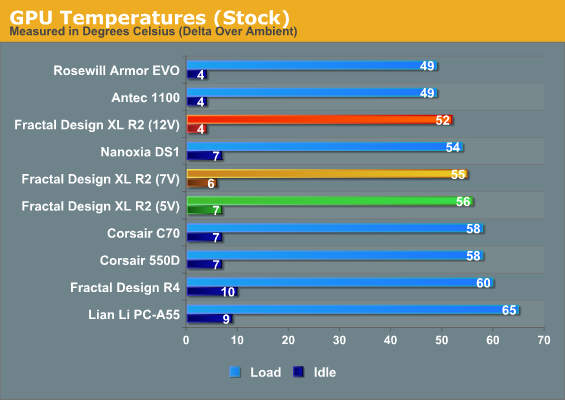
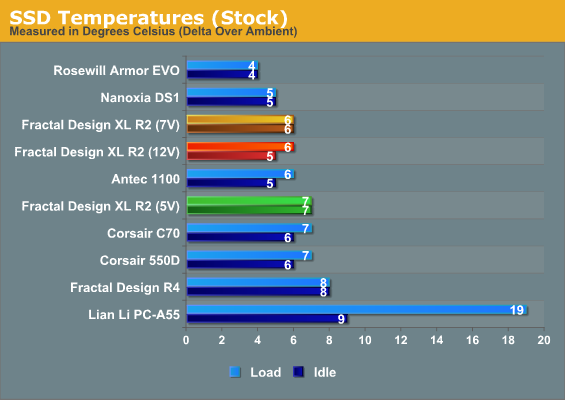
Stock thermals weren't stellar, but they were remarkably competitive. The XL R2 defeats the R4 and is capable of meeting or beating Nanoxia's Deep Silence 1.
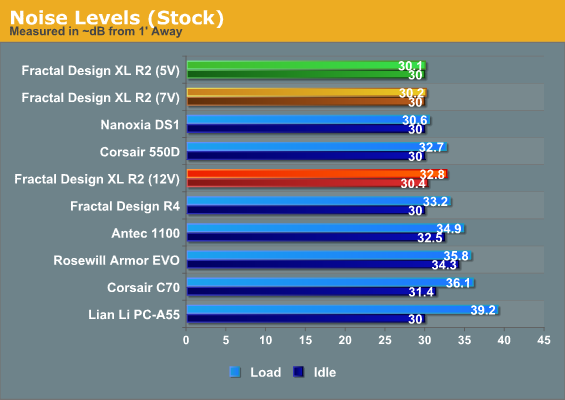
Noise levels are also nearly perfect. The XL R2 is a quiet case and, at least in our stock configuration, is able to pull good thermal performance out of low acoustics.
So far, so good. The XL R2 isn't mind-blowing but it's definitely competitive. As it turns out, though, there's a lot more fight left in the XL R2 than would first appear.
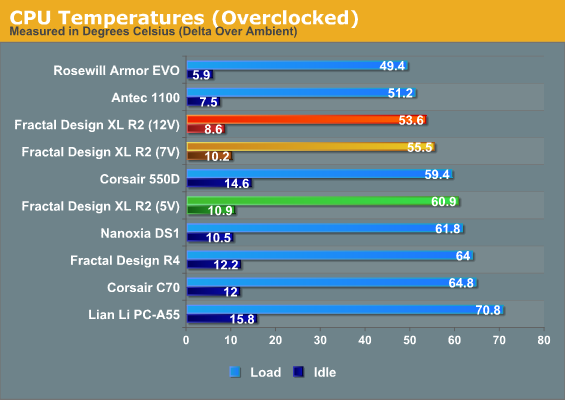
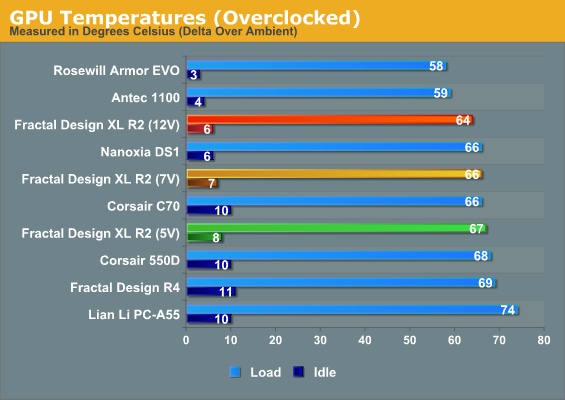
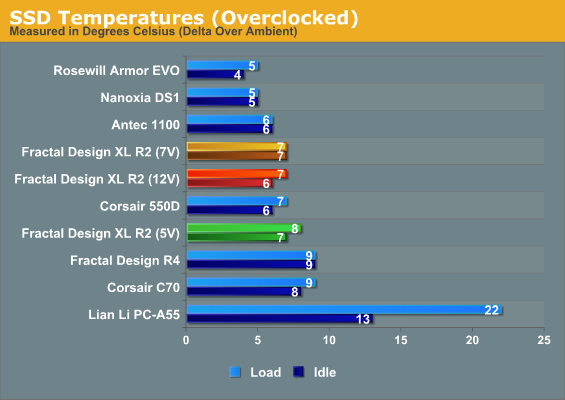
The overclocked testbed usually buries quiet cases, but the XL R2 holds its own. At worst, it's competitive with Nanoxia's formerly class-leading Deep Silence 1. At best, it eclipses it soundly.
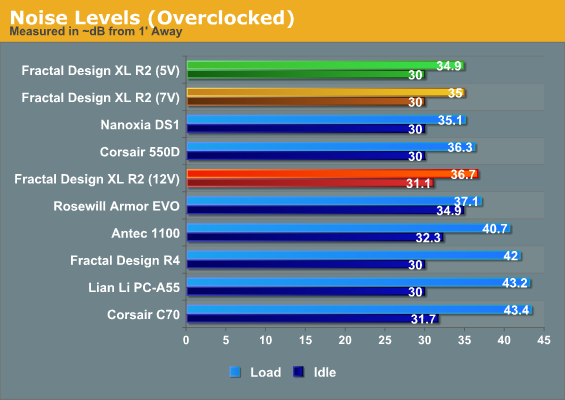
Speaking of sound, the XL R2 is also capable of running at roughly the same sound levels as Nanoxia's case while performing at least as well, if not better. It's true that Fractal Design's case does benefit from a larger footprint, but this is still a pleasant surprise to see.










46 Comments
View All Comments
omgia - Wednesday, February 20, 2013 - link
I moved from a p180 to an Define R4 recently. The most notable difference between this and the p180 is the cable routing. There is a significant difference in the amount of space behind the motherboard for routing cables. Also, my R4 is 4-6 degrees cooler (F) than my Antec P180 was with the supposedly better thermal sections. This may be because these cases uses 140 vs 120mm fans. But also, with the ability to get all of the wires behind the motherboard, you have better airflow. Something I was personally never able to achieve with the P180. I like the build quality of this case better than the P180 as well. Support for front USB 3.0 is also nice. I was thinking about getting a P280, but after completing my build, I have no reservations that the R4 or XL-R2 are better cases.akhaddd - Wednesday, February 20, 2013 - link
eep Silence cases are already pretty heavy and well built in their own right, then add another ten pounds and three inches. The Define XL R2 is made almost entirely of steel with really the bare minimum of plastic used in itslwatcdr - Wednesday, February 20, 2013 - link
With the new closed loop systems from Corsair, NZXT, and Swift tech it would be nice to know which fit in the case. Yes I know you can not test with every Motherboard but they are becoming mainstream so it would be helpful to add that data even if it just "The mounting screws will fit.omgia - Wednesday, February 20, 2013 - link
I just purchased a Define R4 and one of the biggest problems is reaching the 12V lead up to the top-left of the case.I'm sure most would fit if routed over the top of the motherboard, but you really need a long one to route through the grommets.One feature of the XL-R2 and the R4's are mounting spaces for SSDs on the back of the motherboard tray. This seems like a great idea at first, but you must mount it prior to installing the motherboard (meaning you'll have to remove the motherboard to remove the drive). And the mounting positions are far enough away from the other drives, it may be difficult to share a power lead between the drive trays and the 2.5" mount points. I was able to share one with a SATA lead with 3 connectors, but not a lead with 2. The center connector on the lead with 3 became useless.
Not sure about the XL-R2, but on the Define R4, the center drive tray is subject to vibration from mechanical drives. Even with the screws on the drive tray holder secured tightly, there were significant vibrations that could easily be heard outside the case. This was evident even using the bottom screw holes with rubber grommets. I had to torque down these screws hard to get the vibrations to stop.
As far as noise goes, these are silent cases, not silencing cases. The foam may help a little, but it is not going to really do any sound deadening. The case on its own is whisper quiet without any components. But I can still hear hard drives chirping and my noisier cpu fan. If you are replacing an existing case, listen to your system without all of your existing case fans running. That is how it will probably sound with an XL-R2 or Define R4. Maybe a decible or two lower, but nothing significant.
Touche - Wednesday, February 20, 2013 - link
Is that GPU crooked?snakyjake - Wednesday, February 20, 2013 - link
I wanted a large case for a NAS/Multipurpose machine that will be in my home, so need something quiet.bsix - Wednesday, February 20, 2013 - link
With the Define (regular size) cases the inlet airflow is stifled because of the drive cages and the more restrictive cages they use. This problem seems so be solved by using the bottom fan. This is really the only difference in these two cases from an airflow perspective.i bet the R4 would do much better with an additional inlet fan on the bottom and potentially some better case fans that can lower the noise floor an additional 2 db.
This would be really appreciated - I bet the R4 would be equal to both the nanoxia and the XL R2 in acoustics with this setup.
Take care.
stratosrally - Wednesday, February 20, 2013 - link
I do realize that Anandtech is known for pulling no punches (and am thankful for that!) but the article really doesn't come across positively enough. The fact that it is such a large case, comes with 3 fans & a fan controller, and performs so well for a suggested list price of only $129.99 ought to be given more emphasis in this review.The review seems to be almost begrudging in admitting that the XL R2 does so well across the board. For example, the amount of room for cable routing (26mm - more than an inch!) precludes the need for channels in the motherboard plate which would just add complexity and cost.
BTW - the constant promotion of the Nanoxia can be a bit frustrating given that it still isn't available in the US. It, too has no motherboard guide post and you mentioned similar issues in installing the PSU. You also mentioned I/O panel & GPU installation issues. You actually stated you might be coming across as nitpicking in that review, yet gave it the Bronze Editor's Choice Award.
I personally think there's a limit to how much reasonably-priced enclosures can ease assembly. I don't mind installing my own standoffs and paying attention (using both hands, etc.) when installing the PSU. Given the variety of motherboard sizes this case will accept you'd quite possibly be adding or subtracting standoffs anyway.
If I wanted everything done for myself I'd expect to pay a more premium price. As this case is larger and performs equal to or better than the Deep Silence 1 in the tests - IMHO it deserves the Silver or even Gold Award.
five_seven - Thursday, February 21, 2013 - link
After reading so many reviews I, too, am tired of hearing about stand-offs not being installed on a motherboard. An enthusiast building their own PC is doing just that-- building their own PC. If people really feel dragged out by having to figure out how to align a motherboard with a lack of stand-offs or a center stud, they've got bigger problems.Rather than docking any points from your " utterly worthless, arbitrary point system" over this issue, might I suggest simply indicating if a case provides stand-offs and if the user will need to install them or not. Some objectivity in regards to this issue, however, would be nice.
UNhooked - Thursday, February 21, 2013 - link
Once again no watercooling support of any kind was discussed. You really need to start incorporating this. It is now a vital part of case reviews based on mainstream watercooling has become.